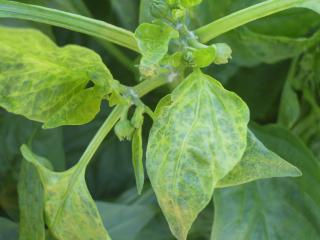Symptoms
CMV infection causes symptoms on leaves including mosaic, mottling, yellowing and chlorotic or necrotic flecks. The fruit of affected plants may become deformed (bumpy and/or puckered) and show ringspots or chlorotic patches, with uneven colour and ripening. The age of the plant when infected and the strain CMV can affect the type and severity of symptoms.
Spread
CMV is spread by many aphid species including Myzus persicae (green peach aphid) and Aphis gossypii (melon aphid). CMV is non-persistently transmitted: an aphid picks up the virus within one or two seconds while probing an infected plant, but the virus is then lost again when the aphid probes one or two healthy plants.
Sources of virus
CMV has a very wide host range that includes ornamentals and weeds (including nightshade, sowthistle, amaranthus) as well as other crops (pumpkins, zucchini, tomatoes). The hosts are often found in close proximity with capsicum crops and can provide a reservoir of infection. CMV is also reported to be seed borne in some weed species.
Management
An integrated disease management approach is needed to control CMV in capsicum crops, one which uses a range of control measures
- Ensure good farm hygiene practices - control alternative weed and crop hosts in and around capsicum crops, also remove infected fruit
- Destroy old crops immediately following harvest to reduce virus and aphid sources
- Avoid planting a new crop immediately next to an older one which may contain sources of virus and aphids
- Avoid planting at a time when aphid numbers are expected to be high, so as not to expose young plants to high risk of infection
- Use healthy virus-tested transplants
- Remove any capsicum plants showing virus symptoms.
- Plant a tall non-host border crop such as sorghum around the capsicum crop approximately 4 weeks before planting. This border acts as a cleansing barrier. Infective aphids that feed on it will lose the virus and no longer be infective if they land on the capsicum crop.
Note: insecticides are ineffective as a control measure for CMV as they do not work quickly enough to prevent aphids from acquiring and transmitting virus.

